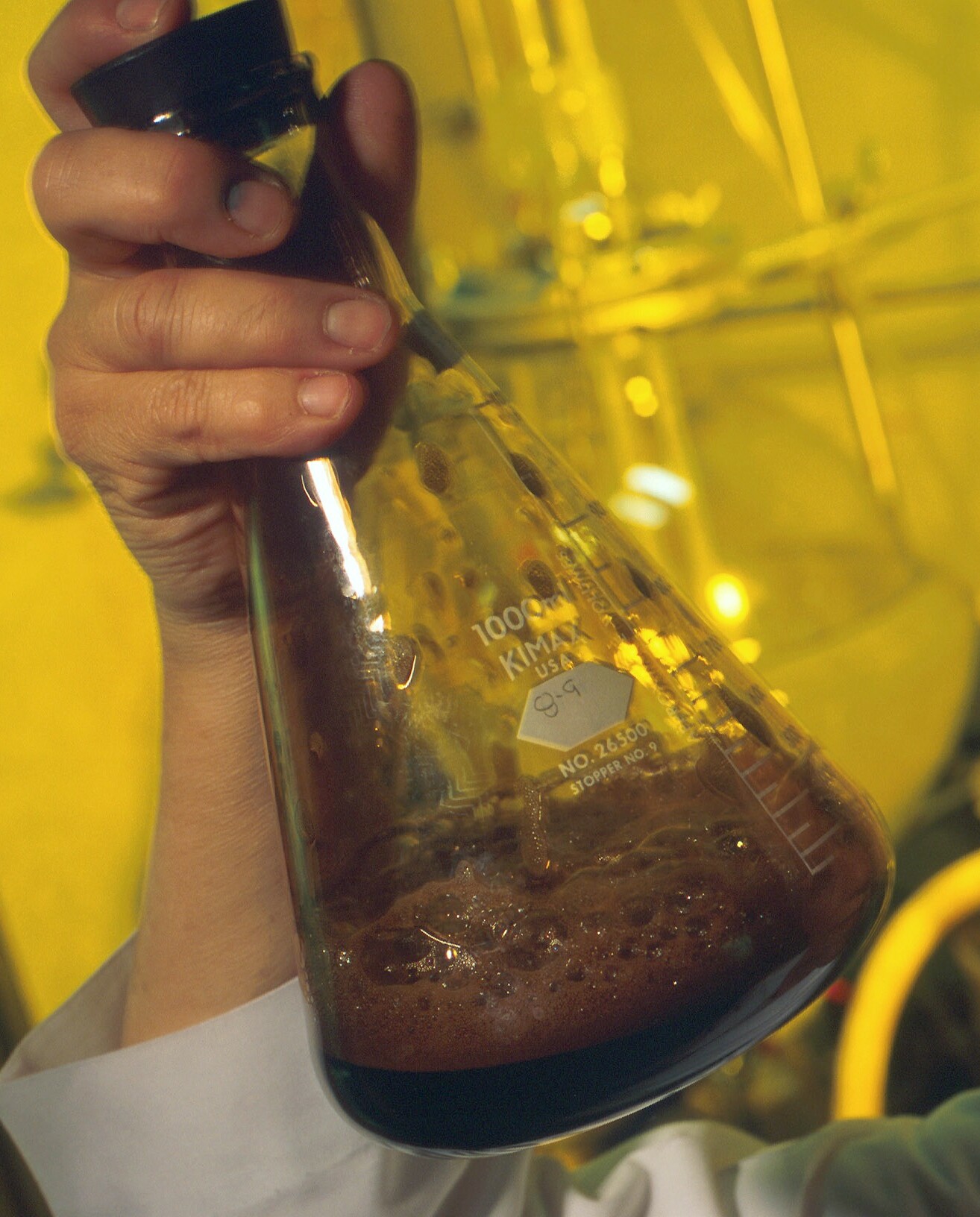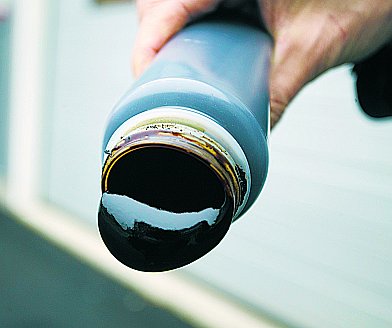Black liquor on:
[Wikipedia]
[Google]
[Amazon]
 In
In
 New
New
 In
In industrial chemistry
The chemical industry comprises the companies that produce industrial chemicals. Central to the modern world economy, it converts raw materials (oil, natural gas, air, water, metals, and minerals) into more than 70,000 different products. The pla ...
, black liquor is the by-product from the kraft process when digesting pulpwood into paper pulp
Pulp is a Lignocellulosic biomass, lignocellulosic fibrous material prepared by chemically or mechanically separating cellulose fibers from wood, fiber crops, Paper recycling, waste paper, or cotton paper, rags. Mixed with water and other chemica ...
removing lignin, hemicellulose
A hemicellulose (also known as polyose) is one of a number of heteropolymers (matrix polysaccharides), such as arabinoxylans, present along with cellulose in almost all terrestrial plant cell walls.Scheller HV, Ulvskov Hemicelluloses.// Annu Rev ...
s and other extractives from the wood to free the cellulose
Cellulose is an organic compound with the formula , a polysaccharide consisting of a linear chain of several hundred to many thousands of β(1→4) linked D-glucose units. Cellulose is an important structural component of the primary cell w ...
fibers.
The equivalent material in the sulfite process is usually called brown liquor, but the terms red liquor, thick liquor and sulfite liquor are also used.
Composition
Approximately 7 tonnes of black liquor are produced in the manufacture of one tonne of pulp. The black liquor is an aqueous solution of lignin residues, hemicellulose, and the inorganic chemicals used in the process. The black liquor comprises 15% solids by weight of which two thirds are organic chemicals and the remainder are inorganic. Normally the organics in black liquor are 40-45% soaps, 35-45% lignin and 10-15% other organics. The organic matter in the black liquor is made up of water/alkali soluble degradation components from the wood. Lignin is degraded to shorter fragments with sulphur content at 1-2% and sodium content at about 6% of the dry solids.Cellulose
Cellulose is an organic compound with the formula , a polysaccharide consisting of a linear chain of several hundred to many thousands of β(1→4) linked D-glucose units. Cellulose is an important structural component of the primary cell w ...
and hemicellulose
A hemicellulose (also known as polyose) is one of a number of heteropolymers (matrix polysaccharides), such as arabinoxylans, present along with cellulose in almost all terrestrial plant cell walls.Scheller HV, Ulvskov Hemicelluloses.// Annu Rev ...
is degraded to aliphatic carboxylic acid soaps and hemicellulose fragments. The extractives gives tall oil soap and crude turpentine
Turpentine (which is also called spirit of turpentine, oil of turpentine, terebenthene, terebinthine and (colloquially) turps) is a fluid obtained by the distillation of resin harvested from living trees, mainly pines. Mainly used as a spec ...
. The soaps contain about 20% sodium.
The residual lignin components currently serve for hydrolytic or pyrolytic conversion or just burning only. Hemicellulosis may undergo fermentation processes, alternatively.
History
Early kraft pulp mills discharged black liquor to watercourses. Black liquor is quite toxic to aquatic life, and causes a very dark caramel color in the water. The invention of the recovery boiler by G.H. Tomlinson in the early 1930s was a milestone in the advancement of the kraft process. By the 1990s, most kraft mills were consuming nearly all of their black liquor byproduct, and purifying the remainder in biological treatment plants, reducing the environmental effect of the waste waters below the level of scientific significance, except perhaps in very small streams. Even in the 21st century, some small kraft mills remained (producing at most a few tons of pulp per day) that discharged all black liquor. However, these are rapidly disappearing. Some kraft mills, particularly in North America, still recovered under 98% of the black liquor in 2007, which can cause some environmental contamination, even when biologically treated. The general trend is for such obsolete mills to modernize or shut down.Usage
The black liquor contains more than half of the energy content of the wood fed into the digester of a kraft pulp mill. It is normally concentrated to 65 - 80% by multi-effectevaporator
An evaporator is a device used to turn the liquid form of a chemical substance, such as water, into a vapor.
Uses
Air conditioning and refrigeration
Some air conditioners and refrigerators use a compressed liquid with a low boiling point, su ...
s and burned in a recovery boiler to produce energy and recover the cooking chemicals. The viscosity
The viscosity of a fluid is a measure of its resistance to deformation at a given rate. For liquids, it corresponds to the informal concept of "thickness": for example, syrup has a higher viscosity than water.
Viscosity quantifies the inte ...
increases as the concentration goes up. At about 50 - 55% solids the salt solubility limit is reached. Tall oil is an important byproduct separated from the black liquor with skimming before it goes to the evaporators or after the first evaporator stage.
Energy source for the pulp mill
Pulp mills have used black liquor as an energy source since at least the 1930s. Most kraft pulp mills use recovery boilers to recover and burn much of the black liquor they produce, generating steam and recovering the cooking chemicals ( sodium hydroxide and sodium sulfide used to separate lignin from the cellulose fibres needed for papermaking). This has helped paper mills reduce problems with water emissions, reduce their use of chemicals by recovery and reuse, and become nearly energy self-sufficient by producing, on average, 66 percent of their own electricity needs on-site. In the United States, paper companies have consumed nearly all of the black liquor they produce since the 1990s. As a result, the forest products industry has become one of the United States' leading generators of carbon-neutral renewable energy, producing approximately 28.5 terawatt hours of electricity annually.Use as biofuel feedstock
Gasification
 New
New waste-to-energy
Waste-to-energy (WtE) or energy-from-waste (EfW) is the process of generating energy in the form of electricity and/or heat from the primary treatment of waste, or the processing of waste into a fuel source. WtE is a form of energy recovery. Mo ...
methods to recover and utilize the energy in the black liquor have been developed. The use of black liquor gasification
Gasification is a process that converts biomass- or fossil fuel-based carbonaceous materials into gases, including as the largest fractions: nitrogen (N2), carbon monoxide (CO), hydrogen (H2), and carbon dioxide (). This is achieved by reactin ...
has the potential to achieve higher overall energy efficiency
Energy efficiency may refer to:
* Energy efficiency (physics), the ratio between the useful output and input of an energy conversion process
** Electrical efficiency, useful power output per electrical power consumed
** Mechanical efficiency, a ra ...
than the conventional recovery boiler, while generating an energy-rich syngas from the liquor. The syngas can be burnt in a gas turbine
A gas turbine, also called a combustion turbine, is a type of continuous flow internal combustion engine. The main parts common to all gas turbine engines form the power-producing part (known as the gas generator or core) and are, in the directio ...
combined cycle to produce electricity (usually called ''BLGCC'' for Black Liquor Gasification Combined Cycle; similar to IGCC) or converted through catalytic processes into chemicals or fuels such as methanol, dimethyl ether
Dimethyl ether (DME; also known as methoxymethane) is the organic compound with the formula CH3OCH3,
(sometimes ambiguously simplified to C2H6O as it is an isomer of ethanol). The simplest ether, it is a colorless gas that is a useful precursor ...
(DME), or F-T diesel (usually called ''BLGMF'' for Black Liquor Gasification for Motor Fuels). This gasification technology is currently under operation in a 3 MW pilot plant at Chemrec's test facility in Piteå, Sweden. The DME synthesis step will be added in 2011 in the "BioDME" project, supported by the European Commission
The European Commission (EC) is the executive of the European Union (EU). It operates as a cabinet government, with 27 members of the Commission (informally known as "Commissioners") headed by a President. It includes an administrative body ...
's Seventh Framework Programme
The Framework Programmes for Research and Technological Development, also called Framework Programmes or abbreviated FP1 to FP9, are funding programmes created by the European Union/European Commission to support and foster research in the Europe ...
(FP7) and the Swedish Energy Agency.
Used for biofuels production, the black liquor gasification route has been shown to have very high conversion efficiency and greenhouse gas reduction potential.
Hydrothermal liquefaction
Hydrothermal liquefaction Hydrothermal liquefaction (HTL) is a thermal depolymerization process used to convert wet biomass, and other macromolecules, into crude-like oil under moderate temperature and high pressure. The crude-like oil has high energy density with a lower ...
is suitable for converting black liquor to advanced biofuels due to the process's ability to handle high moisture inputs.
Extraction of lignin
Where recovery boiler capacity is limited and a bottleneck in the pulp mill the lignin in the black liquor may be extraordinary and exported or used as fuel in the mill'slime kiln
A lime kiln is a kiln used for the calcination of limestone ( calcium carbonate) to produce the form of lime called quicklime (calcium oxide). The chemical equation for this reaction is
: CaCO3 + heat → CaO + CO2
This reaction can take p ...
, thereby often replacing fossil based fuel with biofuel.
U.S. tax credit 2007–2010
A tax credit created by the U.S. Congress in 2005 as part of the2005 Highway Bill
Safe, Accountable, Flexible, Efficient Transportation Equity Act: A Legacy for Users or SAFETEA-LU was a funding and authorization bill that governed United States federal surface transportation spending. It was signed into law by President Geor ...
to reward and support the use of liquid alternative fuel
Alternative fuel, known as non-conventional and advanced fuels, are any materials or substances that can be used as fuels, other than conventional fuels like; ''fossil fuels'' (petroleum (oil), coal, and natural gas), as well as nuclear materi ...
derived from hydrocarbons in the transportation sector was expanded in 2007 to include non-mobile uses of liquid alternative fuel derived from biomass. This change meant that, in addition to fish processors, animal renderers and meat packers, kraft pulp producers became eligible for the tax credit as a result of their generation and use of black liquor to make energy. For one large company (International Paper
The International Paper Company is an American pulp and paper company, the largest such company in the world. It has approximately 56,000 employees, and is headquartered in Memphis, Tennessee.
History
The company was incorporated January 31 ...
) this could amount to as much as $3.7 billion in benefits. Weyerhaeuser
Weyerhaeuser () is an American timberland company which owns nearly of timberlands in the U.S., and manages an additional of timberlands under long-term licenses in Canada. The company also manufactures wood products. It operates as a real e ...
announced in May 2009 that it was also pursuing the tax credit. Some paper industry analysts criticized the paper industry's eligibility for the alternative fuel mix tax credit on the grounds that it increased fossil fuel use, but the industry countered that adding a fossil fuel was a requirement of the law and that, regardless, this did not result in a net increase in fossil fuel use since companies were merely replacing the existing fossil fuel they already mixed with black liquor—natural gas—with one of the three fuels specified by the law: gasoline, kerosene or diesel. The bio-fuel credit for black liquor ended on January 1, 2010.
References
{{DEFAULTSORT:Black Liquor Papermaking Pulp and paper industry Biogas substrates